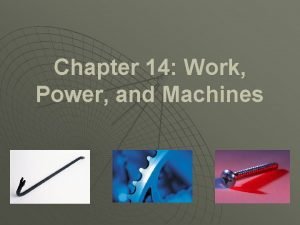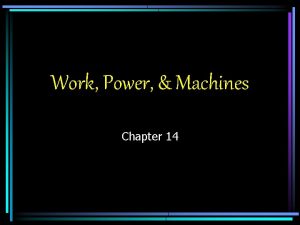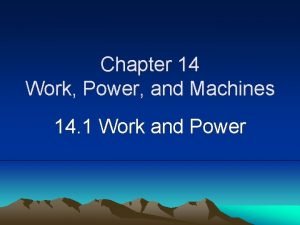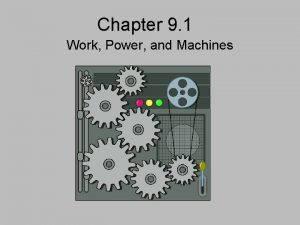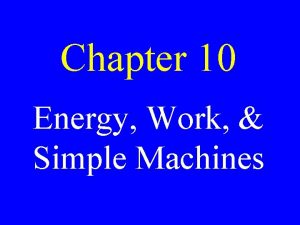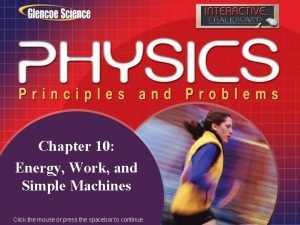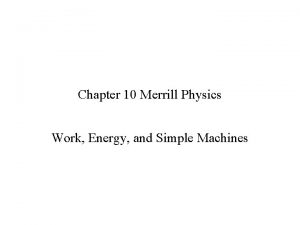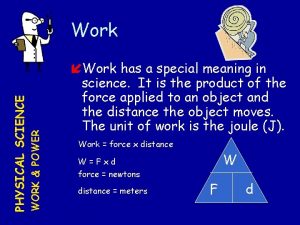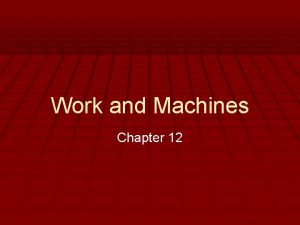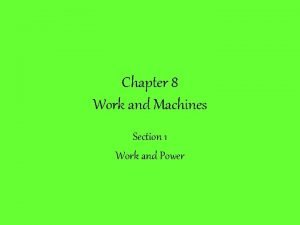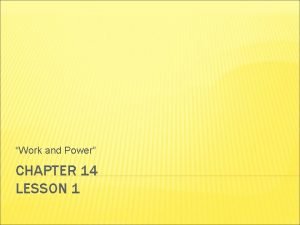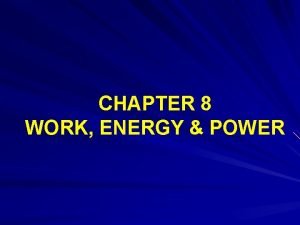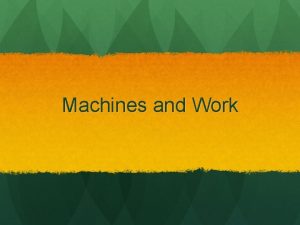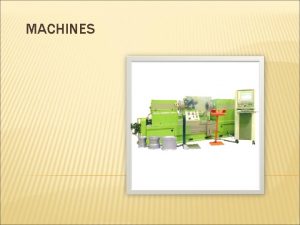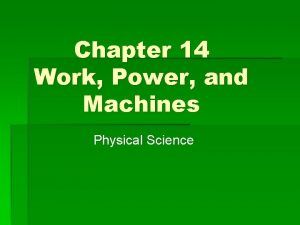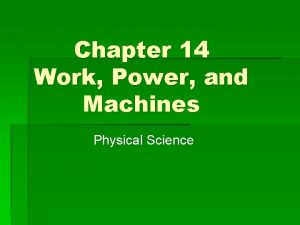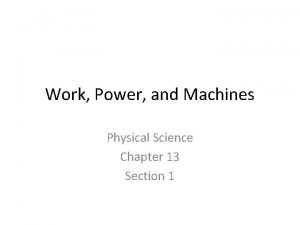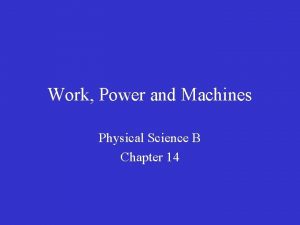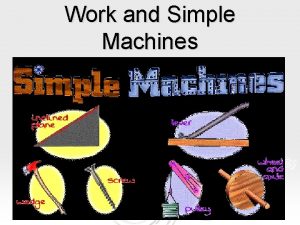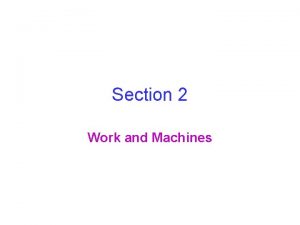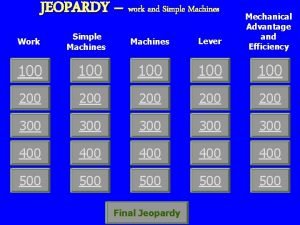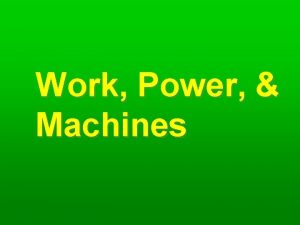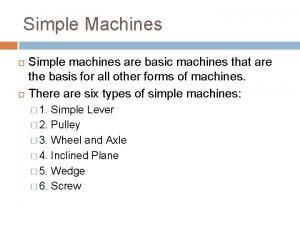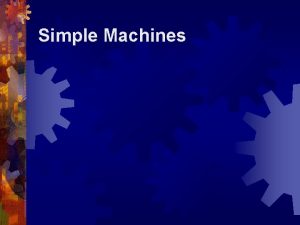Work Power and Machines Physical Science Chapter 13



















- Slides: 19

Work, Power, and Machines Physical Science Chapter 13 Section 1

Work • Occurs when a force causes an object to change its motion or position. • Calculated by multiplying the force by the distance over which the force is applied. • Work = force x distance • W = FD

Work • This weightlifter is holding a barbell over his head. Is he doing any work on the barbell?

Work • Imagine a father playing with his daughter by lifting her repeatedly in the air. How much work does he do with each lift if he lifts her 2 m and exerts an average force of 190 N? – Force, f = 190 N – Distance, d = 2 m – Work, W = ? J • W = 190 N x 2 m = 380 J

Work Practice #1 • A crane uses an average force of 5200 N to lift a girder 25 m. How much work does the crane do on the girder?

Work Practice #2 • An apple weighing 1 N falls a distance of 1 m. How much work is done on the apple by the force of gravity?

Work Practice #3 • A bicycle’s brakes apply 125 N of frictional force to the wheels as the bike move 14 m. How much work do the brakes do?

Work Practice #4 • A mechanic uses a hydraulic lift to raise a 1200 kg car 0. 5 m off the ground. How much work does the lift do on the car?

Work Practice #5 • A car breaks down 2. 1 m from the shoulder of the road. 1990 N of force is used to push the car off the road. How much work has been done on the car?

Work Practice #6 • Pulling a boat forward into a docking slip requires 1570 J of work. The boat must be pulled a total distance of 5. 3 m. What is the force with which the boat is pulled?

Work Practice #7 • A box with a mass of 3. 2 kg is pushed 0. 667 m across a floor with an acceleration of 3. 2 m/s 2. How much work is done on the box?

Power • The rate at which work is done. – Power = work/time – P = W/t

Power • Lifting an elevator m takes 100000 J. If doing so takes 20 s, what is the average power of the elevator during the process? – Work, w = 100000 J – Time, t = 20 s – Power, P = ? W – P = 100000 J/20 s = 5000 W (watts)

Power Practice #1 • While rowing across the lake during a race, John does 3960 J of work on the oars in 60 s. What is his power output in watts?

Power Practice #2 • Anna walks up the stairs on her way to class. She weights 565 N, and the stairs go up 3. 25 m. • If Anna climbs the stairs in 12. 6 s, what is her power output? • What is her power output if she climbs the stairs in 10. 5 s?

Machines • Machines change the size and/or direction of forces. • A mechanical advantage is a quantity that expresses how much a machine multiplies force or distance. • Mechanical advantage = output force/input force = input distance/output distance

Mechanical Advantage • Calculate the mechanical advantage of a ramp that is 5 m long and 1. 5 m high. • Input distance = 5 m • Output distance = 1. 5 m • Mechanical advantage = ? • Mechanical advantage = input distance / output distance = 5 m/ 1. 5 m = 3. 3

Mechanical Advantage Practice #1 • Find the mechanical advantage of a ramp that is 6 m long and 1. 5 m tall.

Mechanical Advantage Practice #2 • Alex pulls on the handle of a claw hammer with a force of 15 N. If the hammer has a mechanical advantage of 5. 2, how much force is exerted on the nail in the claw?
 Chapter 4 work and energy section 1 work and machines
Chapter 4 work and energy section 1 work and machines Chapter 14 work power and machines
Chapter 14 work power and machines Chapter 14 work power and machines
Chapter 14 work power and machines Chapter 14 section 1 work and power
Chapter 14 section 1 work and power Work power energy and machines
Work power energy and machines Work power and machines
Work power and machines Ma=fr/fe
Ma=fr/fe Chapter 10 energy, work and simple machines answer key
Chapter 10 energy, work and simple machines answer key Energy work and simple machines chapter 10 answers
Energy work and simple machines chapter 10 answers Chapter 10 energy work and simple machines answer key
Chapter 10 energy work and simple machines answer key Power physical science
Power physical science Real power and reactive power
Real power and reactive power Branches of science
Branches of science Natural and physical science
Natural and physical science The force you exert on a machine
The force you exert on a machine Section 1 work and machines
Section 1 work and machines Work and energy section 2 describing energy answer key
Work and energy section 2 describing energy answer key Is your a subject
Is your a subject Chapter 14 section 1 work and power
Chapter 14 section 1 work and power Chapter 8 work and power answers
Chapter 8 work and power answers

